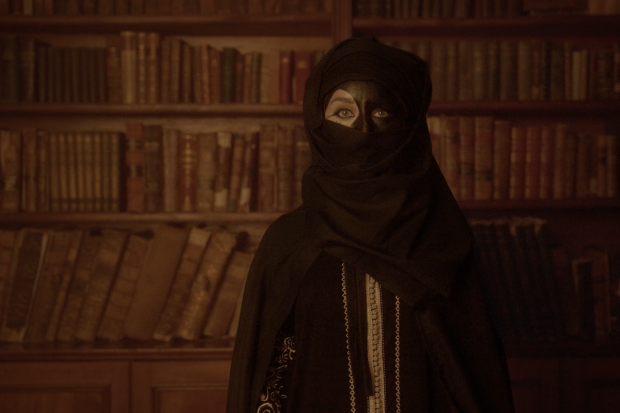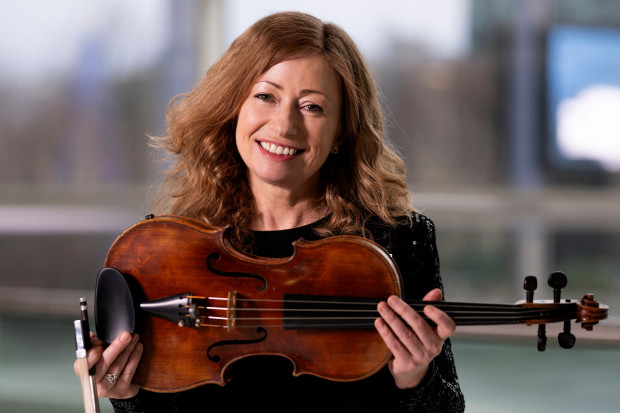
Composer and Co-Director of Ergodos, Benedict Schlepper-Connolly (Photo: Frances Marshall)
The Past Inside the Present: The Ergodos Exploration of Time
Ergodos’ aesthetic vision over the years has been remarkably consistent. My first encounter with Ergodos came when reviewing its 2009 concert of vocal music at the Kevin Barry Room. In ‘an overall solemn if not reverential affair,’ as I described it, ‘a recurring theme was the searching backwards glance of the present to times past – “the past inside the present”, to quote a tune by Boards of Canada.’
The four recent Ergodos albums discussed here are all similarly veiled in pastness, as indicated in their respective titles: The weathered stone (Schlepper-Connolly); What is living and what is dead (O’Connor); Left Behind (O’Connor and O’Rourke) – each title evoking a sense of absence and exposure in a precipitous present. While the fourth album, David Collier’s album Smacht, might seem an exception to this, the choice of an Irish word here for ‘control’ or ‘order’, and the origin of the composition in question in a film that was to chart a journey across the Irish rural landscape, metonymise those elements – the Irish language, the native landscape, disciplined composure – towards creating an artistic fortification on a certain image of our heritage. Collectively it’s an undoubted maturation of Ergodos’ vision.
Shared grammar
Alongside the shared programmatic imagery of pastness and of the natural landscape, the musical vocabulary of these four albums also by and large has a shared grammar. The compositions are generally characterised by a proclivity for neo-tonal or modal musical material; cellular repetition-and-variation; explicit sentimentality; a shunning of traditional barriers between genres; and a distaste for overtly intellectual references. This expresses a youthful effort neither to pre-conceive composition nor to police oneself aesthetically. Garrett Sholdice, one of Ergodos’ directors, once expressed his attitude in this regard, by contrast with some of their predecessors, in a phrase of Feldman’s: ‘The operation was a success but the patient died.’
The over-academising of much notated art music, in other words, simply ended up producing a cadaverous music at a remove from the broader public. In their own aesthetic, the Ergodos composers wish by contrast to pursue a more stripped-down, quiet, direct musical style, taking as preliminary role models Feldman, Dennehy and Volans (the first of whom was the focus of an early Ergodos festival ‘Life After Feldman’, and the last two of whom Ergodos have worked with).
Debut
The weathered stone is Benedict Schlepper-Connolly’s debut album. The album’s lead-off track is the titular The weathered stone, a piano trio in five linked movements the general trajectory of which moves from tension to relaxation. The opening minor key movement is airy: the strings and the piano’s left hand sparingly voice a basic two-chord progression while the right hand plays an insistent tritone figure; by the last movement the music has shifted to a major key, the time signature now evoking a jig whose rhythm, driven by the strings’ counterpoint, judders and shakes, every now and again dropping a beat or two. This overall trajectory from darkness to light is, of course, a traditional one, and the symbolic title, The weathered stone, is consistent with this: an atavistic stone in a field, ages-old, enduring, as indicating a past and lineage of which, despite our current time’s instability, we remain a part.
Of the three other tracks on Schlepper-Connolly’s album the most striking is ‘Beekeepers’, which features the composer singing. The song’s melody has a folk-like contour, and Schlepper-Connolly’s voice – faintly vulnerable in the manner of Robert Wyatt – is backed by spectralism-esque chords on piano, string quartet and chalumeau. Needless to say, this format signals a departure: it’s not often you hear a composer of ‘serious notated music’ singing a folk-like song on his portrait album. Atmospherically, ‘Beekeepers’ has a strange sense of anachronism, of time being out of joint. The album’s sifting over ‘the secret histories of landscapes, old maps and memory,’ as the press release puts it, is twinned by Schlepper-Connolly’s musical processes, which are characterised by the delicate sifting and reworking of intervallic and melodic cells.
Slow-building
David Collier’s album Smacht comprises the title track – a single movement string quartet lasting twenty-three minutes – a percussion quartet, Dusk, and a remix of the title track. The string quartet Smacht is the standout, a fine, slow-building piece full of pathos and overt sentimentality built on a simple minor key progression (coincidentally the same two chords, i and VI, that underpin the opening section of Schlepper-Connolly’s The weathered stone). What’s perhaps most intriguing in the quartet Smacht is how it uses a familiar two-chord framework to push beyond itself to something unfamiliar. The chord sequence repeats hypnotically, builds imperceptibly, until after a while the root of the chord drops out and we’re left with the bare outlines: harmonics, tremolo – trace-lines suspended in the air – and finally a violin at the top of its register repeatedly sounding two scratchy notes, exposed as a traveller at dawn. From the point of view of genre, were Jónsi from Sigur Rós to start singing at any point during Smacht, it wouldn’t feel like a surprise, the style of the music being decidedly hybrid.
Glimmers
Simon O’Connor’s album What is living and what is dead for solo piano (performed by Michael McHale) is an hour-long meditative, introspective work that similarly lounges in being hard to place. The mostly tonal harmonic language of What is living and what is dead is at times inflected with the odd octatonic contour, calling to mind Arvo Pärt; Keith Jarrett’s in there, too, in the conception, as is O’Connor’s former teacher Volans; and the first movement (of nine) recalls the main theme from Thomas Newman’s score for American Beauty. Such references aside, extended duration and emotional directness are key to the work’s effect, and the reverb pedal being depressed for the entire piece creates an ambient brume for the work’s glimmers. The overriding atmosphere is inert, alternating gentleness and anergia, and perhaps more would be desirable in the way of contrast. The aptness of the cover art is worth mentioning: a thin red pole in the middle of a dark seascape, isolated and vulnerable as a Giacometti torso.
Intimate
Simon O’Connor’s other album, with Michelle O’Rourke, Left Behind – Songs of the 1916 Widows, is a studio recording of Ergodos’ highest-profile live project to date. Composed to commemorate the Easter Rising, Left Behind eschews grand elegy in favour of the intimate and the personal. The focus is not on traditional heroics but on the private lives affected by history’s grand sweep, the wives of the some of the soldiers killed in the Rising and its aftermath, each of the six songs being sung (by O’Rourke, in rich voice) from the perspective of one of the widows. ‘By the Yew Tree: Song of Maud’ presents the reflections of Maud Gonne towards a public that blackens her name. ‘From the Water: Song of Muriel’ presents Muriel Gifford, wife of Thomas McDonagh, at the moment of her death from a heart attack whilst swimming in Skerries; its instrumentation – delicately chiming piano, double bass and ride cymbal – and chromatic shifts bringing to mind Radiohead. ‘Your Face Through Time: Song of Kathleen’ opens with traditional Irish music style vocal rhythm and lilt. ‘Carousel: Song of Áine’ in its drifting triple metre spin suggests the carousel of the title, light piano chords backed by subtle mallet-struck tom and ride cymbal, over which, in a Björk-tinged melody, O’Rourke sings: ‘Mo mhúinteoir chráite / In the stillness of it all, / Time spins around us, / We rise tall, tall.’
The chaos of time
The statement in ‘Carousel: Song of Áine’ might be taken as a summary of Ergodos’ artistic vision. Throughout these albums we are presented with the priority of the personal and the familiar as a steadying bulwark against the chaos of time. For me it’s a vision that is not without some problems. At times the romanticising of the rural and the traditional does not entirely ring true. As someone whose early life was spent in north-west Donegal I find Thomas Bernhard’s intense vision of rural life in some ways more accurate than the placidity of, say, Seamus Heaney’s. From a stylistic point of view, if Ergodos has found in the over-academising of much new music a restrictive conservatism, one could argue that the limitation of one’s musical palette to neo-tonality entails a similar risk of eventually leading to an analogous type of conservatism. Some might miss on the music of these albums the absence of dissonance, of the chaotic, of the psychedelic: elements of post-1945 new music that, contrary to stereotypes, can feel all the more affirmative for feeling real. It’s important to raise these criticisms, I think, and equally important to acknowledge the engagedness and timeliness of what Ergodos is doing in Irish music. It offers an exemplary case of La Monte Young’s artistic dictum, Draw a straight line and follow it. The itinerary that that line will take Ergodos on will be intriguing to see.
–
The weathered stone, Smacht, What is living and what is dead and Left Behind– Songs of the 1916 Widows are all available from ergodos.ie.
Published on 9 February 2017















